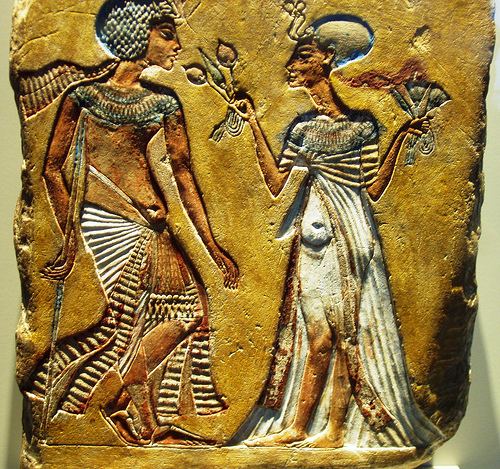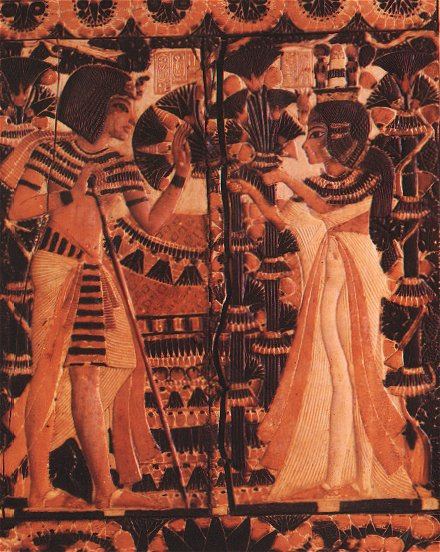Name Ankhesenamun Ankhesenamun | ||
 | ||
Similar People | ||
Here comes the king tutankhamun ankhesenamun
Ankhesenamun (ˁnḫ-s-n-imn, "Her Life Is of Amun"; c. 1348 – after 1322 BC) was a queen of the Eighteenth Dynasty of Egypt. Born as Ankhesenpaaten, she was the third of six known daughters of the Egyptian Pharaoh Akhenaten and his Great Royal Wife Nefertiti, and became the Great Royal Wife of her half-brother Tutankhamun. The change in her name reflects the changes in ancient Egyptian religion during her lifetime after her father's death. Her youth is well documented in the ancient reliefs and paintings of the reign of her parents. Tutankhamun and Ankhesenamun shared the same father but Tutankhamun's mother has recently been established by genetic evidence as one of Akhenaten's sisters, a daughter (so far unidentified) of Amenhotep III.
Contents
- Here comes the king tutankhamun ankhesenamun
- Ankhesenamun in Ancient Egypt
- Early life
- Later life
- Hittite letters
- Mummy KV21A
- KV63
- In popular culture
- References

She was most likely born in year 4 of Akhenaten's reign and by year 12 of her father's reign she was joined by her three younger sisters. He possibly made his wife his co-regent and had his family portrayed in a realistic style in all official artwork.

Ankhesenamun was definitely married to one king; she was the Great Royal Wife of Pharaoh Tutankhamun. It is also possible that she was briefly married to Tutankhamun's successor, Ay, believed by some to be her maternal grandfather. It has also been posited that she may have been the Great Royal Wife of her father, Akhenaten, after the possible death of her mother, and co-regent of Akhenaten's immediate successor, Smenkhkare.

Recent DNA tests released in February 2010 have also speculated that one of two late 18th dynasty queens buried in KV21 could be her mummy. Both mummies are thought, because of DNA, to be members of the ruling house.

Ankhesenamun in Ancient Egypt
Early life
Ankhesenpaaten was born in a time when Egypt was in the midst of an unprecedented religious revolution (c. 1348 BC). Her father had abandoned the old deities of Egypt in favor of the Aten, hitherto a minor aspect of the sun-god, characterised as the sun's disc.
She is believed to have been born in Waset (present-day Thebes), but probably grew up in her father's new capital city of Akhetaten (present-day Amarna). The three eldest daughters – Meritaten, Meketaten, and Ankhesenpaaten – became the "Senior Princesses" and participated in many functions of the government and religion. Her birthdate is not known.
Later life
She is believed to have been married first to her own father. This was not unusual for Egyptian royal families. She is thought to have been the mother of the princess Ankhesenpaaten Tasherit (possibly by her father or by Smenkhkare) when she was twelve, although the parentage is unclear.
After her father's death and the short reigns of Smenkhkare and Neferneferuaten, she became the wife of Tutankhamun. Following their marriage, the couple honored the deities of the restored religion by changing their names to Tutankhamun and Ankhesenamun. The couple appear to have had two stillborn daughters. As Tutankhamun's only known wife was Ankhesenamun, it is highly likely the fetuses found in Tutankhamun's tomb are her daughters. Some time in the ninth year of his reign, at about the age of eighteen, Tutankhamun died suddenly, leaving Ankhesenamun alone without an heir at about age twenty-one.
A ring discovered is thought to show that Ankhesenamun married Ay shortly before she disappeared from history, although no monuments show her as a royal consort. On the walls of Ay's tomb it is Tey (Ay's senior wife), not Ankhesenamun, who appears as queen. She probably died during or shortly after his reign and no burial has been found for her yet.
Hittite letters
A document was found in the ancient Hittite capital of Hattusa which dates to the Amarna period; the so-called "Deeds" of Suppiluliuma I. The Hittite ruler receives a letter from the Egyptian queen, while being in siege on Karkemish. The letter reads:
"My husband has died and I have no son. They say about you that you have many sons. You might give me one of your sons to become my husband. I would not wish to take one of my subjects as a husband... I am afraid."
This document is considered extraordinary, as Egyptians traditionally considered foreigners to be inferior. Suppiluliuma I was surprised and exclaimed to his courtiers:
"Nothing like this has happened to me in my entire life!"
Understandably, he was wary, and had an envoy investigate, but by so doing, he missed his chance to bring Egypt into his empire. He eventually did send one of his sons, Zannanza, but the prince died, perhaps murdered, en route.
The identity of the queen who wrote the letter is uncertain. She is called Dakhamunzu in the Hittite annuals, a possible transliteration of the Egyptian title Tahemetnesu (The King's Wife). Possible candidates are Nefertiti, Meritaten, and Ankhesenamun. Ankhesenamun seemed once likely since there were no candidates for the throne on the death of her husband, Tutankhamun, whereas Akhenaten had at least two legitimate successors. but this was based on a 27-year reign for the last 18th pharaoh Horemheb who is now accepted to have had a shorter reign of only 14 years. This makes the deceased Egyptian king appear to be Akhenaten instead rather than Tutankhamun. The phrase regarding marriage to 'one of my subjects' (translated by some as 'servants') is possibly a reference to the Grand Vizier Ay or a secondary member of the Egyptian royal family line. Since Nefertiti was depicted as powerful as her husband in official monuments smiting Egypt's enemies, she might be the Dakhamunzu in the Amarna correspondence as Nicholas Reeves believes. Ankhesenamun may have been pressured by Ay to marry him and legitimise his claim to the throne of Egypt (which she eventually did) This also might explain why she describes herself as 'afraid', especially considering the popular (but not widely accepted) theory that Ay had a hand in her husband's death. A CT scan taken in 2005 shows that he had badly broken his leg shortly before his death, and that the leg had become infected. DNA analysis conducted in 2010 showed the presence of malaria in his system. It is believed that these two conditions, malaria and leiomyomata, combined, led to his death. However, Ankhesenamun was not as powerful as Nefertiti to be able to choose her spouse from a foreign state.
Mummy KV21A
DNA testing announced in February 2010 has speculated that her mummy is one of two 18th Dynasty queens recovered from KV21 in the Valley of the Kings.
The two fetuses found buried with Tutankhamun have been proven to be his children, and the current theory is Ankhesenamun is their mother. Not enough DNA was able to be retrieved from the mummies in KV21 to make positive identities of the queens. Enough DNA was pulled to show that The Mummy known as KV21a fits as the mother of the two fetuses in Tutankhamun's tomb. The assumption that she is Ankhesenamun fits with her being the only known wife of Tutankhamun in the historical record.
There is however one problem with this identification: if KV21a is Ankhesenamun, then the KV55 mummy probably is not Akhenaten, known to be her father from historical records. The DNA retrieved of the KV21a mummy fits with her being the mother of the fetuses, but not the daughter of KV55. Therefore:
Nevertheless, the KV21a mummy has DNA consistent with the 18th dynasty royal line, therefore making it likely she was a member of the Thutmoside ruling house and supporting her identification with Ankhesenamun.
KV63
After excavating the tomb KV63 it is speculated that it was designed for Ankhesenamen due to its proximity to the tomb of Tutankhamun's KV62. Also found in the tomb were coffins (one with an imprint of a woman on it), women's clothing, jewelry and natron. Fragments of pottery bearing the partial name Paaten were also in the tomb. The only royal person known to bear this name was Ankhesenamen, whose name was originally Ankhesenpaaten. However, there were no mummies found in KV63.
In popular culture
Ankhesenpaaten/Ankhesenamum appears as a fictionalized character in these works:
